It is now officially the 90s! It’s the time to wear flannel, parachute pants, sunglasses and hats on backwards, at least according to what pop culture tells me.
There’s nothing good on TV though so we go to gaming for our
entertainment. In the realm of gaming,
technology was going into the next generation.
The Sega Genesis released in
SNK released the Neogeo. This thing was a beast with some of the highest possible memory capacity allowing for the most detailed graphics and the best sound, all with expandable memory cartridges that would allow for even bigger and better games throughout its 14 year run, one of the longest in gaming history. When it came to 2D games, the Neogeo was at the top of the line.
The Neogeo system wasn’t just a super powered arcade machine
like with Capcom’s CPS though. It had
several innovations and quirks that made it particularly attractive to arcade
owners. Instead of every game needing a
dedicated cabinet, the Neogeo arcade system had swappable cartridges and could
hold anywhere from 3-6 games that could be switched between with the press of a
button when the current game wasn’t being played. This means it was cheaper, saved floor space
and in the case of
The Neogeo was the hardware that even to this day defines SNK’s identity. For the next several years of this competition, it’s SNK’s sole arcade system. I’ll discuss the Hyper Neogeo 64 when the time comes, but for reasons I’ll explain, its games will not be included.
Just because it’s an arcade powerhouse doesn’t mean its games were always good though. Capcom’s technology and pedigree were still no slouch. Whether the Neogeo has what it takes to win the 90s we will have to see, but before the official debut, there were still a few Capcom games that came out.
Mercs(CAP): For whatever reason, only the Japanese version of this game with its Japanese title is available on the Capcom Arcade Stadium. It’s a sequel to Commando in which you and up to two friends play as an elite mercenary team and rescue the president from terrorist. From purely a game design standpoint Mercs is competently done and benefits from the CPS board for its visuals. Everything animates nicely, all the enemies die or explode in a satisfying enough fashion and the fact that 3 players can play at once like with Beast Busters wasn’t very common and a neat feature.
Mercs ultimately suffers from the same problem S.A.R. does: nothing about it stands out and I forget about it as soon as I finish playing. It ticks all the boxes of making a decent run & gun shooter, but stops there. It’s a standard story where you use the standard shooter weapons against standard enemies.
1941: Counter Attack(CAP): The 1942 series of games have been some of the most boring and generic in Capcom’s library for me, lacking real personality by virtue of simply being a war plane shooting stuff. This prequel tries to change it up with more environments and more elaborate bosses. Levels and enemies have a bit more going on in them to set them apart from each other, unlike the first game, but most of the game is still the usual gunning down of an army of planes that gets old. It’s a step in the right direction, but it’s still mediocre.
Magician Lord(SNK): This and ‘Nam 1945 were the first two games to come packaged with the Neogeo and Magician Lord is one giant flex of the system’s power. The music is multi-layered and epic, there’s a whole prologue intro movie in the home version, there’s fully acted dialogue with awful translations and the graphics are on par with the best Capcom has had to offer thus far. The ability to transform into a wide variety of forms with different weapons further shows off the system’s memory capacity. Magician Lord has everything going for it. There’s just one snag: the difficulty.
To its credit, Magician Lord has a better difficulty curve than the likes of Ghosts n’ Goblins, starting out fairly challenging, but not too hard. At those points, it’s awesome and even game of the year material. Sadly it gradually reaches the aforementioned game’s difficulty, albeit without dying in one hit. It controls great and still has moments of greatness, with boss fights being a highlight, but there are too many times where you’re swarmed by enemies you can’t hope to fight off or blindsided by something you couldn’t have seen coming, including when the foreground covers an enemy.
This is all tolerable if you’re willing to constantly continue after dying, but Magician Lord is notable for being one of the only games for the Neogeo in which the home port has a significant difference from the arcade one. If you play the arcade version, you can continue from where you left off with credits, but in the home version, you continue from checkpoints like Ghosts n’ Goblins. You have unlimited continues in either case, but that makes the home version brutal because it means you can’t power through anything. It doesn’t help that most ports of the game that have come out over the years have been the home version, but Hamster’s Neogeo port of the arcade version is readily available on modern systems. I would recommend that version, but however you play it, Magician Lord has a lot of action platforming goodness and stands out from other games of 1990.
Top Player’s Golf(SNK): Unlike Magician Lord, this one isn’t here to show off the Neogeo’s power. In fact, most of this game could probably run on a Sega Genesis. It’s just a simple golf game. You choose your wedge, angle the ball, take wind into account, gauge your power with the right timing and get your ball in the hole. There’s quite a lot of content, with two sizable courses, 3 game modes and caddy assistants who act as sort of an easy mode by giving advice and telling players how far the hole is.
It’s a game you can bust out to play with the filthy casuals; easy to play, but with depth and variables. It’s all competently done. Even if sports games like this aren’t something I get pumped for at their mere mention, it’s a welcome break from all the shooting and slashing and I’m certainly not getting any breaks like that from Capcom.
Magic Sword(CAP): This game is generic in every sense of the
word. The story tells you nothing, the
characters and enemies are all stock and the gimmick of having assist
characters makes so little difference that you’d swear they were thrown in to
try and make the game less generic. The
whole thing is just devoid of personality or anything to make it stand
out. What you’re doing for the first 5
minutes of Magic Sword is basically all you do for the rest of the game’s long
run time. Even if I wasn’t spoiled by
Magician Lord, Capcom’s own
Mega Twins(CAP): The game is for kids. It has enough story to make the kids feel like they’re on an adventure, the graphics are bright and cutesy and all the violence of hitting enemies with your sword is softer and more fantasy-like than the meaty sound effects and visible pain from other games of its type.
As an action platformer it’s competently done. Everything that makes for a good one is here, including easy to use wall jumps. Since this is for the kiddies, it’s the easiest one yet. There are very few cheap shots in this game because most everything is telegraphed and enemy attacks move much slower than what the hardcore players might be used to. It’s the Weenie Hut Jr. of action platformers. Not Super Weenie Hut Jr., because it does make you put in effort, but some players might find Mega Twins too easy. I think it has its place. This game has care and attention put into it and I’m sure it made some 8 year old happy when they were able to beat it without having to spend a fortune continuing. As an adult, there is a certain feelgood vibe the game has and it looks, controls and sounds good enough. It gets a pass.
Ninja Combat(SNK): You can’t say Ninja Combat isn’t unique for 1990 beat-em-up. There are several different characters that you gain the further you get into the game, an aesthetic that’s a combination of Double Dragon and Ninja Gaiden, making for a setting that could only come out of the 90s and gameplay that’s more reminiscent of a shoot-em-up, where you can rapid fire a projectile at enemies. Unfortunately, objectively, it’s not very good. There are very few combat options beyond rapid-firing your attack. You can dodge roll, but you can get hit during it so it’s practically useless and you can jump, but there’s almost never any reason to do so. The only other viable combat ability is taking a page from Capcom by sacrificing health to do an area-clearing super move, but this game is so relentlessly difficult and unfair that you’ll need to do that constantly.
The biggest issue is how easy it is to get stunlocked to death and it only takes a few hits to kill you in the first place. At least with Final Fight you had some invicibility when you were knocked down and weapons and throwing gave you some strategy to the combat. There are weapons only the main characters can pick up in Ninja Combat, but they drop the weapons when they’re hit, which is all the time. There’s such little depth and it eventually devolves into hitting the attack button as much as you can while letting the game inhale this month’s paycheck.
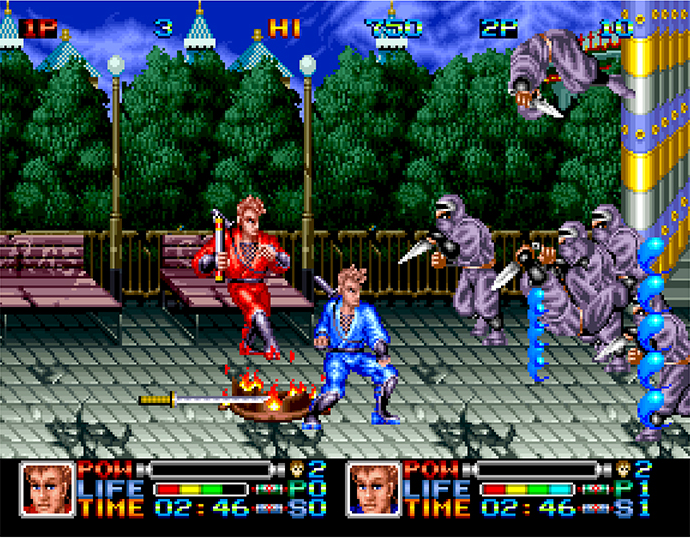 |
| That title don't lie. |
Ninja Combat has some of that 90s cheese in its presentation that might make it worth a play for some mild entertainment, but I wouldn’t drop much money on it. It does come bundled in with some actually good games on both the Neogeo Arcade Stick Pro and the PS2 game compilation ADK Damashi, which is available on the PS4, so in that sense you don’t have to drop money on it if you buy one of those for the better games. In both collections they’re in Japanese, but trust me, you are not missing anything if you don’t understand what’s being said. For ADK Damashi you have to navigate the collection’s Japanese main menu though.
The Super Spy(SNK): This game had so much going for it. If I told you about the basic parts that make up the game, it would sound awesome. The manual sets up the story about a badass action hero who, after a catastrophic bombing from a notorious terrorist group, goes into a building the terrorists have taken over to make more bombs so that he may prevent another such tragedy.
There are profiles for the main character and the terrorist leaders and the buildings you go into are full of NPCs with dialogue that’s mostly meaningless, but try to put you in the situation of bystanders being present and hiding for safety. Sprites are large and expressive with sprite scaling used to simulate depth, enemies go flying in a satisfying as hell manner when you finish them with a good kick or uppercut and you’re given a healthy number of combat options like ducking, blocking, shooting and stabbing.
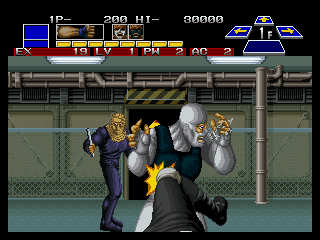 |
| Ungh! Yeah! Take that! |
I would be able to tolerate a lot of the game’s shortcomings if it didn’t seem to be deliberately wasting my time. You can’t go anywhere without fighting enemies, which is standard for a beat-em-up, but they really took it too far in this game. This is a game where you have to navigate maps and sometimes have to backtrack. Being forced to stop and fight enemies with the game’s unpolished combat the entire way while backtracking makes the game overstay its welcome really fast. Maybe if you could fight enemies on the way it might flow better, but like I said, it wastes your time. If you know what you’re doing the game takes at least 90 minutes, which for an arcade game, especially one that runs out of variety really fast, that is way WAY too long! Some people have suggested that the game was made to be long to push the Neogeo memory cards so you’d have to play it over several play sessions and I can believe that, but who wants to play this after the first session?
I can’t even say the story conveyed through dialogue is interesting because this is one of the most botched translations I’ve ever seen. In Japanese characters have fairly lengthy dialogue and in English there’s barely any dialogue that’s largely nonsense.
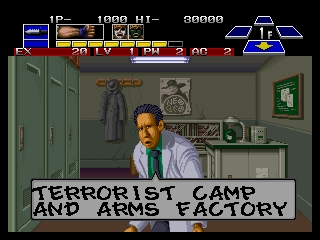 |
| Why'd they make the English text so huge? |
Carrier Air Wing(CAP): It seemed as though for the ship-based shooter Capcom was being largely outclassed for a while, but this one is a smashing success. Carrier Air Wing takes place over the course of several missions around the world and before each one you can use money earned from a previous mission to be armed to the teeth and when you’re armed to the teeth against an army of enemies armed to the teeth the resulting dental clash is something to behold. Glorious explosions everywhere with tight controls, fitting music and graphics that are better than what the Neogeo has displayed in some ways. Despite enemy fire flying everywhere at all times, the game’s difficulty feels fair thanks to slower projectile speed. There are few situations where getting hit is unavoidable, it just takes fast reaction and awareness.
Players used to bullet hell shooters will feel right at home with Carrier Air Wing, but anyone wanting a good shoot-em-up should give Carrier Air Wing a play. The game is almost an hour long, but unlike The Super Spy it doesn’t pad itself out or get repetitive. It’s all very tightly made and while it doesn’t do anything very ambitious to innovate on the genre, it does deliver on being a well-designed top-level shooter and for that it is 1991’s game of the year.
Puzzled(SNK): What an interesting little spin on Tetris. All you have to do is make rows of blocks to remove them and clear the way for a balloon at the bottom to hit the top. Easy, right?
Wrong.
The overall gameplay premise is that simple, but the actual game is torture to play and easily the most relentlessly difficult puzzle game I’ve ever played. Puzzled is methodical, requiring precision and thinking ahead. There’s already a hit to the precision in that you can only use one button to rotate blocks counter-clockwise and the B button is for a bomb that can blow up blocks around the balloon once in a blue moon. I guess they missed that there are 4 buttons on the Neogeo.
The way stages in Puzzled are set up means you have to chip away at pre-set blocks to clear the way for the balloon, but the game doesn’t like the methodical gameplay it set up so it doesn’t take long for it to demand you hurry up and speed up the block dispensing to the point that it’s impossible. As early as the second stage you have to pause the game as soon as a block comes out so you can survey the field and think of the optimal place to put it, but with the randomization element of the blocks, even that can be a crapshoot so you’ll really want to abuse save states.
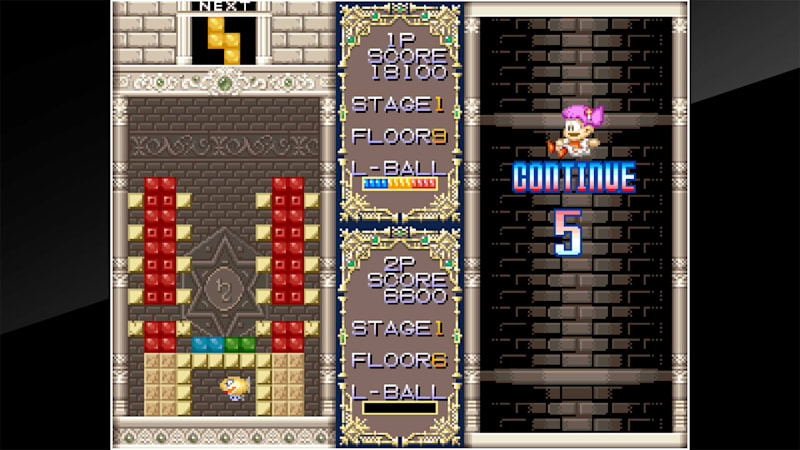 |
| Pain. |
League Bowling(SNK): This game is even simpler than golf. All you have to do is position your bowler, then use timed button presses to determine angle and power. As simple as that is, it’s a pretty fun distraction backed by 3 different game modes and the option to play with up to 4 players, taking turns at the machine. In fact, if you have the right cabinets it’s possible to play with 8 players.
What really sells it is the presentation. Each of the palette-swapped bowlers are super expressive and the animations for the different results essentially function as the silly animations you see at a bowling alley like Main Event. The alley in League Bowling also looks like the place to be, with cheering spectators and excited bowlers on the inside and a pretty neon sign on the outside. I genuinely wish it made appearances in other SNK games. I know Terry would go bowling there.
I actually played this game with a bunch of other people of varying inebriation at a brewery establishment once and we had a great time going for the best score and spectating everyone else while it wasn’t our turn, just like real bowling. What League Bowling does is simple, but it goes it very effectively.
The Winner
As much as I played up the Neogeo and its power, this was a pretty weak year for both Capcom and SNK, with most of their games ranging from passable to just plain bad. Ultimately it comes down to who had the most standout games coupled with the number of genuine failures. SNK had its standout Magician Lord and 2 major failures with The Super Spy and Puzzled, but Capcom had a more consistent output of mediocre to ok games with its only failure being the particularly uninspired Magic Sword to go alongside its standout Carrier Air Wing and maybe Mega Twins. By that quantifiable assessment, Capcom defeats SNK’s juggernaut for 1990.
Maybe next year SNK will have better memory sizes and learn from this mistake. It’s not like Capcom is going to revolutionize an entire genre of gaming or anything.
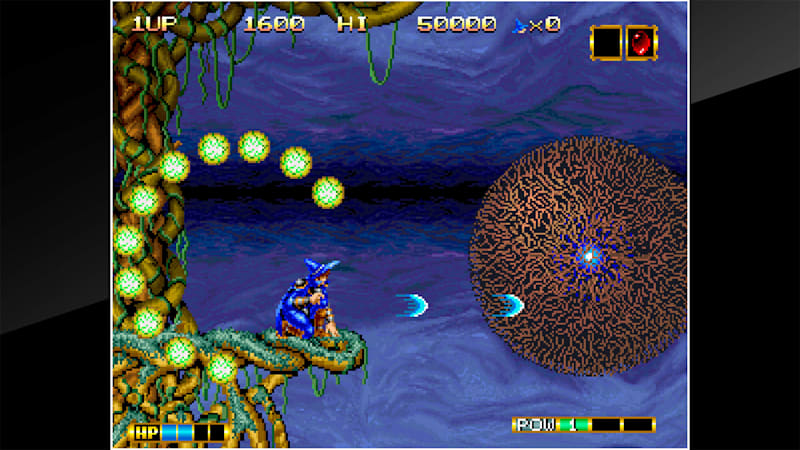
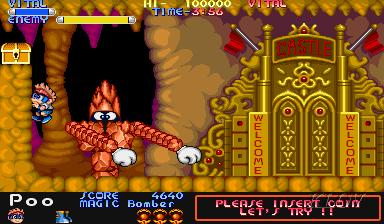


No comments:
Post a Comment